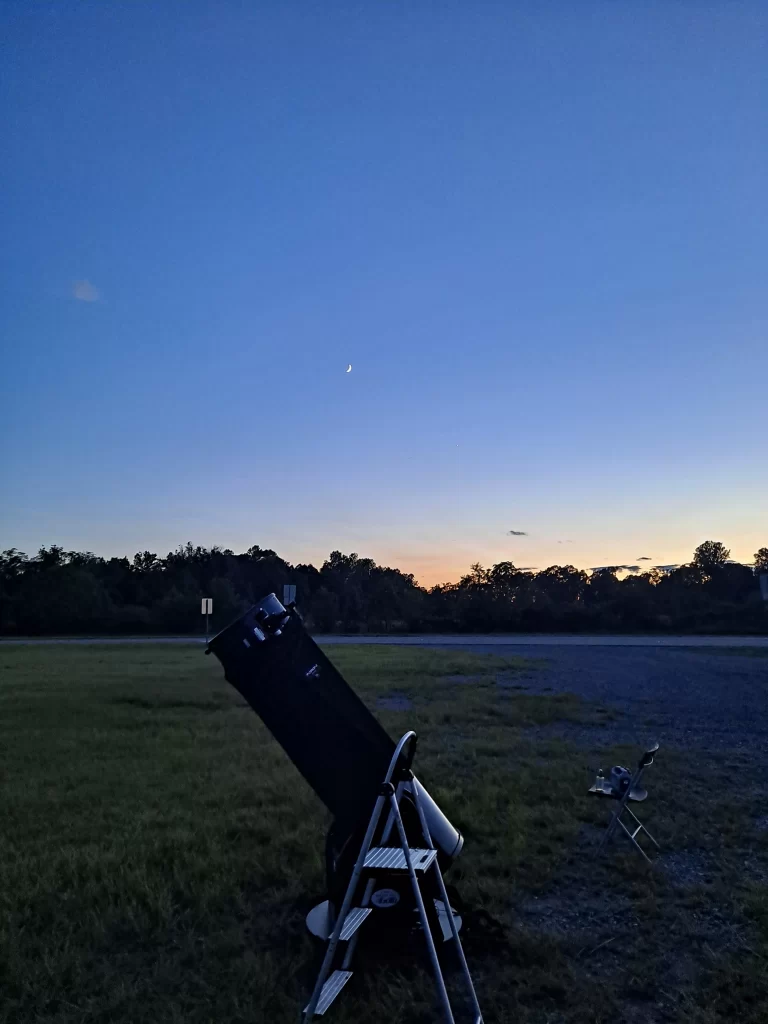Telescope mounts are generally either solid or tripod style. The way they sit on the group is different depending on your mount.
When observing with a telescope is it important that the mount is stable, that it does not wobble or move when you are observing, however it is not necessary for it to be level. If you are using a GoTo telescope and you are not getting perfect results, try leveling the scope and see if it fixes the problem.
Some tripod telescope mounts have a bubble on the base. The same kind you would see on a traditional level. This is a guide, but just eyeballing this is fine. There is no need to be precise.
When setting up your equipment for a night of observing, it is much more important that you get a stable spot and get an accurate two or three star alignment.
Stable Telescope vs Level Telescope
Although it is not important for your scope to be level in most cases. You should always keep your scope stable when observing.
Your telescope should not wobble or shift up and down when moving. If you do not have reasonably flat ground you may need to shim it so it does not jolt from side to side.
You can use pieces of wood for this or even a towel that you may have in your kit to keep the scope stable.
Keep your tightening knobs on the base of your Dobsonian tight as well.

You can observe anything visually as long as your telescope is stable.
If you are using counterweights, stability is even more important. You can use a dovetail to add more counterweight when using a heavy eyepiece.
Consider moving or removing counterweights. Some of my eyepieces are a pound or more. This can really mess with the balance. It can result in my scope tipping over.
If you use counterweights, always keep your scope very stable. Counterweights can dramatically change the balance of your scope. They often make moving the scope easier and smoother, but if your scope is not sable they will just cause it to tumble.
I remember when I was using my Dobsonian telescope on the hill in my backyard, it was not very stable. I was using a heavy eyepiece and slewing low in the sky. It got scary for a moment, if my telescope had tumbled down the hill it could have come out of collimation at best or damaged the optical tube or mirrors at worst.
When does a telescope need to be level?
In most situations it is not important to level your telescope. When observing with a goto the two or three star alignment is much more important than leveling.
Leveling a telescope is only important when using an equatorial or Alt-az mount with goto for long exposure astrophotography. Even in these situations, generally the level is often good enough. If you need more precise tracking, leveling may be beneficial.
I have never carried a level or tried to level my goto Dobsonian. I have been happily observing through my wildly unlevel telescope for over a year now.
Does it matter if my go-to scope is level?
While it is not necessary for a telescope to be perfectly level, having a goto telescope roughly level can improve the tracking performance. An accurate two or three star alignment is far more important than a level scope. If you are experiencing problems with your GoTo, leveling your scope is an easy solution to try.
I have a SyncScan and I did read the suggestion to level your scope. I travel 90% of the time I observe and I do not know where I will be setting up. I have found that
One time when I was observing with my 16 inch (very heavy) goto telescope in the gravel lot by my house the scope was not level at all. I noticed that when my scope was slewing it started making a grinding noise.
The mechanism that moves my scope is two places that slide over each other and I think it was distributing the weight unevenly. I had to stick a towel under the scope to more evenly distribute the weight to keep the plates from grinding together.
Even after I did that, it was still rocking back and forth a little, but I was still able to enjoy the observing session. The goto was happy enough.
I was able to do a two star alignment even with this far from perfect setup. The objects were still in the field of view, although not perfect.
Do I need to level my Dobsonian Mount?
I have used my Dobsonian on a hill, as long as it isn’t going to tumble then the telescope will work perfectly fine.
Dobsonian telescopes do not need to be level to work. Remember that you are observing from earth, but you are looking to the sky. Objects in space are best observed in relationship to one another much more than their relationship to the earth.
I use my scope for visual observing and I find that I have to pay very little attention to the ground when I set up.
If your Dobsonian has GoTo, be sure that it is reasonably level with the ground and very stable. You never know where it is going to point and this could result in your scope falling over.
I have seen my GoTo take the long way to a very close object. It can be super unpredictable.
These telescopes can also be top heavy, making it easier for it to fall over. Also, some eyepieces are very heavy and can significantly change the balance of the whole thing.
Do I need to level my tripod telescope mount?
Many new astronomers find themselves with a tripod telescope. They are also more popular for astrophotography.
I want to just remind you that leveling is a terrestrial measurement, it has to do with the relationship between two things on earth. When observing with a telescope it is more important that you orient yourself with objects in space.
It is unnecessary to level your tripod telescope, but you may choose to polar align the scope for very precise observing and photography.
What is polar alignment?
If you are using an equatorial mounted telescope, you may choose to do a polar alignment. A polar alignment uses Polaris to orient you in the cosmos.
Polar alignment is most important for long exposure astrophotography.
The interesting thing about this is it reminds you of your position in the universe. When we level things, this is keeping us oriented with the earth. Polar alignment is orienting yourself in space.
Doing a polar alignment does not require a perfectly level scope, it requires a precise alignment with the poles of our planet and Polaris.
I do not have any experience with this type of telescope or this type of alignment. At this point I have only done visual observing with a Dobsonian telescope. This is one reason I chose a Dobsonian, it is the simpler, more beginner friendly choice. They do not have to be polar aligned at all.




